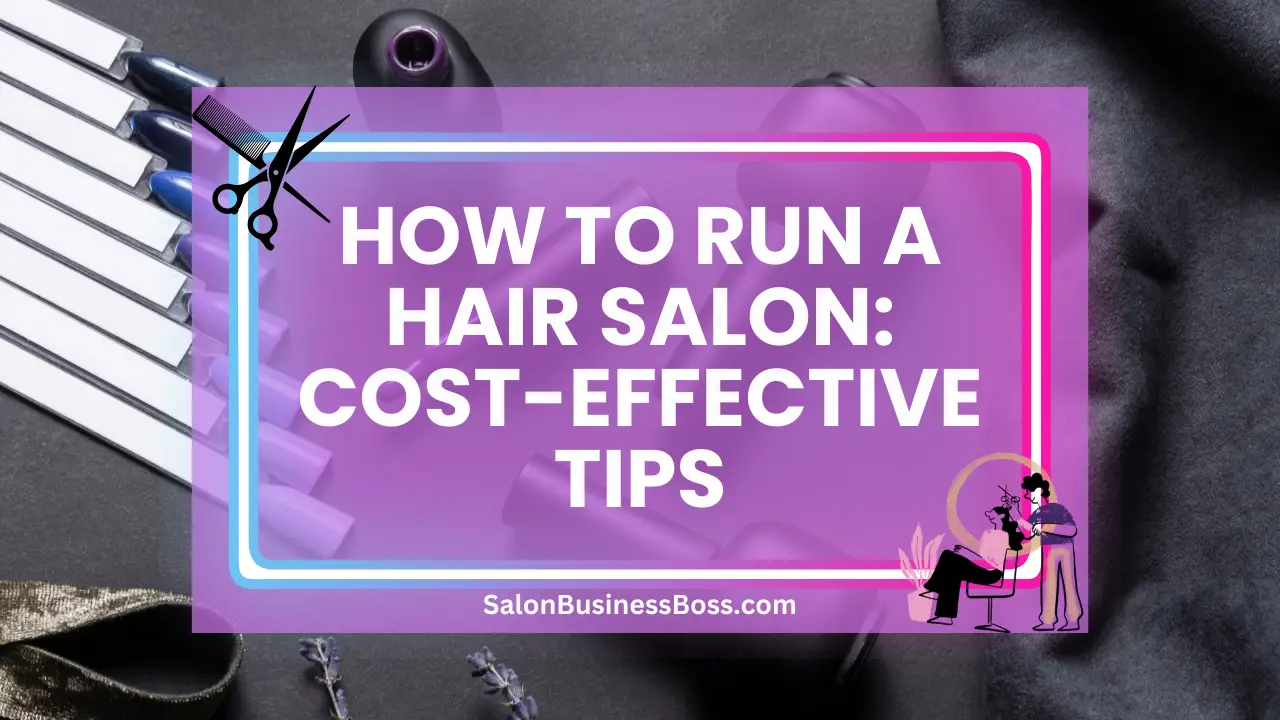Running a hair salon involves more than just cutting and styling hair. It requires a strategic approach to ensure customer satisfaction, staff motivation, and continuous growth. In this article, we will delve into the key elements that contribute to a thriving hair salon business.
To run a hair salon, foster creativity with a dedicated team, document the creative process for consistency, empower staff to participate and share ideas, and implement a tailored education system. Embrace technology, mentorship, and regular feedback to ensure continuous growth and exceptional customer satisfaction.
1. The Power of a Creative Team:
In the competitive world of hair salons, staying ahead of trends and offering unique services is crucial for success. A powerful way to achieve this is by establishing a creative team within the salon. This team should consist of experienced stylists, colorists, and other creative talents who are passionate about pushing the boundaries of hairstyling.
By coming together on a weekly or monthly basis, this team can engage in brainstorming sessions where they exchange ideas, experiment with new techniques, and explore innovative hair trends. The collaborative efforts of this creative team can breathe fresh life into the salon’s offerings, attracting more clients and setting the establishment apart from competitors.
The creative team serves as a source of inspiration for other staff members. As they try out new styles and color combinations, they can document their findings. This documentation is a valuable resource for the entire salon, as it ensures consistency in service delivery. Stylists can refer to these records to recreate successful styles and learn from each other’s experiences.
The creative team fosters a culture of continuous improvement, where staff members are encouraged to explore their creativity and passion for hairdressing. As clients witness the salon’s commitment to innovation, they’ll be more likely to choose the salon as their go-to place for cutting-edge hairstyles and personalized services.
2. Enhancing and Documenting the Creative Process:
In the dynamic world of hairdressing, creativity is the lifeblood of success. To continuously improve and refine the salon’s creative process, it is crucial to maintain a comprehensive record of the ideas, techniques, and outcomes explored by the creative team.
When the creative team introduces new hairstyles or color combinations, documenting the details is essential. This includes noting the specific techniques used, the products applied, and the resulting outcomes. This information becomes a valuable reference for all stylists in the salon, ensuring that everyone is on the same page when it comes to offering consistent and high-quality services.
The documentation of the creative process goes beyond just recording ideas. It also provides a means for skill-sharing among staff members. By reviewing and analyzing the documented styles and outcomes, stylists can learn from each other’s successes and challenges. This collaborative learning environment not only elevates the skills of individual team members but also strengthens the salon’s collective expertise.
The documentation serves as a repository of inspiration and innovation. Stylists can refer to past successes and build upon them to create new and exciting hairstyles for their clients. This not only saves time in brainstorming new ideas but also ensures that the salon is always offering fresh and cutting-edge services.
By enhancing and documenting the creative process, a hair salon can foster a culture of continuous growth and improvement. This commitment to staying ahead of trends and offering innovative styles sets the salon apart in a competitive market, attracting clients who seek personalized and trendsetting hairstyles.
3. Encouraging Staff Participation:

In a thriving hair salon, the staff’s active participation and sense of ownership in the salon’s success are invaluable. Fostering a culture of open communication and participation starts with creating an environment where employees feel comfortable sharing their ideas and opinions.
Regular team meetings are an essential platform for staff members to come together and discuss various aspects of salon operations. These meetings provide an opportunity to address challenges, celebrate successes, and brainstorm potential improvements. Encourage staff to actively contribute their insights, as their on-the-ground experience can offer valuable perspectives that might otherwise be overlooked.
Recognizing and rewarding outstanding contributions further reinforces the importance of each team member’s role in the salon’s progress. Acknowledging exceptional efforts can be as simple as a word of praise during team meetings or implementing an employee recognition program. By doing so, staff members feel appreciated and motivated to continue making meaningful contributions.
Promote a sense of ownership by involving employees in decision-making processes that affect the salon’s operations. Seek their input when introducing new services, updating salon policies, or making changes to the workspace. This involvement helps employees feel valued and invested in the salon’s growth.
Read more about: How to Run a Successful Hair Business: Standing Out from Competitors
4. Creating an Education System:
The success of a hair salon is directly linked to the competence of its staff. An effective education system is essential to ensure that all team members stay updated with the latest trends, techniques, and industry best practices.
Start by conducting a thorough assessment of the staff’s skill levels and identifying areas where additional training is needed. Design workshops, classes, or seminars accordingly, focusing on those identified areas. Involve senior stylists, colorists, or other experienced professionals to lead these training sessions. Their expertise and real-world experiences can offer valuable insights to other staff members.
Consider bringing in industry experts or external trainers for specialized training. This diversifies the learning experience and exposes the staff to different approaches and perspectives.
Embrace technology and online learning resources to supplement in-person training. Online courses, video tutorials, and interactive assessments can provide flexibility and convenience for staff members to enhance their skills at their own pace.
Regularly assess the effectiveness of the education system by seeking feedback from staff. This allows you to make necessary adjustments and improvements to ensure the training meets the staff’s needs and the salon’s objectives.
A well-implemented education system empowers staff members to continuously grow and improve, leading to enhanced client satisfaction and a competitive edge in the market.
5. Tailored Training Programs:
In a hair salon, recognizing the unique strengths and areas of improvement among staff members is essential for their professional development. A one-size-fits-all approach to training often falls short in catering to the diverse needs of the team. Instead, invest in tailored training programs that address individual requirements, leading to a more skilled and motivated staff.
Start by conducting assessments to identify the specific areas where each staff member can benefit from additional training. Some stylists may excel in color techniques but require improvement in cutting styles, while others may need assistance in customer service or salon management. Customized training programs ensure that staff members receive the right training to enhance their skills and address their specific areas of growth.
Tailored training not only improves technical expertise but also boosts confidence and job satisfaction among staff members. When employees feel that their unique needs and career goals are being addressed, they are more likely to be engaged and committed to their roles in the salon. This, in turn, leads to increased loyalty and reduced turnover.
By focusing on the individual growth of each team member, a hair salon can foster a culture of continuous improvement and support the professional development of its staff. The resulting skill enhancements and positive work environment contribute to delivering exceptional customer service and elevating the salon’s reputation in the industry.
6. Mentorship Opportunities:
Mentorship plays a pivotal role in shaping the future of a hair salon by nurturing the potential of newer team members. Pairing experienced stylists with those who are at the early stages of their careers creates mentorship opportunities that offer numerous benefits.
Mentors serve as guides, providing mentees with insights into various aspects of hairdressing, including technical skills, customer service, time management, and industry etiquette. Mentees can learn from the real-world experiences of their mentors, gaining practical knowledge that might not be found in traditional training settings.
Mentorship also fosters a sense of camaraderie within the salon. The mentor-mentee relationship encourages open communication, where mentees can seek advice and share their challenges without hesitation. This support system creates a positive and nurturing work environment, which ultimately leads to higher job satisfaction and improved staff retention.
Experienced professionals find fulfillment in mentoring, as it allows them to pass down their knowledge and expertise to the next generation of hairdressers. This transfer of knowledge ensures that the salon’s values, techniques, and quality of service are upheld over time.
By embracing mentorship opportunities, a hair salon invests in the growth and development of its staff, fostering a cohesive and skilled team that continuously raises the bar for exceptional hairdressing services.
7. Embrace Technology and Online Learning:
Embrace Technology and Online Learning:

In today’s digital age, incorporating technology into the education system of a hair salon is essential to ensure continuous learning and growth. Online learning resources can be valuable additions to traditional in-person training, offering numerous benefits for both the salon and its staff.
By providing access to online courses, webinars, and tutorial videos, staff members have the flexibility to learn at their own pace and convenience. This is especially beneficial for busy stylists who may find it challenging to attend in-person training sessions regularly. Online learning allows them to revisit materials as needed, reinforcing their understanding of various techniques and concepts.
Online platforms also enable the salon to conduct interactive assessments and quizzes, enhancing engagement and understanding among staff members. These assessments can gauge the progress and knowledge of individual stylists, allowing the salon to identify areas where additional training may be required.
Embracing technology in the education system demonstrates the salon’s commitment to staying current with industry trends and advancements. It sends a message to staff members that continuous learning is valued and encouraged, fostering a culture of professional development within the salon.
By leveraging technology and online learning resources, a hair salon equips its staff with the tools they need to thrive in a rapidly evolving industry. The enhanced skills and knowledge gained through online learning contribute to delivering exceptional services to clients and elevating the salon’s reputation.
Read more about: How to Run a Salon: Ensuring a Relaxing and Luxurious Experience
8. Performance Assessment and Feedback:
Effective performance assessment and feedback mechanisms are integral to maintaining a high standard of service in a hair salon. Regular evaluations provide valuable insights into staff members’ strengths and areas for improvement, ensuring continuous growth and improvement.
Performance assessments should encompass both technical skills and customer interactions. Evaluating technical skills involves observing stylists during actual hairdressing tasks and analyzing their techniques. Feedback should be specific, highlighting areas where improvements can be made and acknowledging areas of strength.
Customer interactions are equally important, as they directly impact the salon’s reputation and client satisfaction. Salon staff should be assessed on their communication, empathy, and problem-solving abilities. Customer feedback and reviews can be valuable sources of information in this regard.
Creating a supportive environment for feedback is crucial. Staff should be encouraged to see feedback as an opportunity for growth and improvement, rather than criticism. Constructive feedback helps stylists identify areas where they can excel and provides a roadmap for professional development.
Positive reinforcement for good performance is equally vital. Recognizing and rewarding staff for their efforts and achievements boosts morale and motivation, leading to increased job satisfaction and loyalty.
Performance assessments should be conducted regularly, ensuring that the salon’s standards are consistently met. By nurturing a culture of continuous improvement through performance assessment and feedback, a hair salon can thrive and provide exceptional services that exceed client expectations.
Conclusion
Running a successful hair salon requires a delicate balance between creativity, staff empowerment, and continuous learning. Establishing a creative team, documenting the creative process, encouraging staff participation, and implementing a well-structured education system are key elements that contribute to the salon’s growth and success. By investing in your staff’s professional development and fostering a supportive work culture, your hair salon will undoubtedly stand out in a competitive industry. Embrace innovation, and always strive to provide exceptional services to exceed customer expectations.
Frequently Asked Questions

1. How can I maintain a hygienic and safe environment in my hair salon?
A: Implement strict sanitation protocols, train staff on hygiene practices, and regularly inspect and clean all salon equipment.
2. What role does social media play in promoting my salon?
Utilize social media platforms to showcase your salon’s work, engage with clients, and run promotions to attract new customers.
3. How can I stay ahead in a competitive hair salon market?
Stay updated with industry trends, invest in staff training, continuously improve customer experience, and differentiate your salon with unique services or offers.
To learn more on how to start you own salon checkout my startup documents here.
Please note that the contents of this blog are for informational and entertainment purposes only and should not be construed as legal advice. Any action taken based on the information provided in this blog is solely at your own risk. Additionally, all images used in this blog are generated under the CC0 license of Creative Commons, which means they are free to use for any purpose without attribution.

About the author. Entrepreneur and Salon Business Fan.
Hi! I am Shawn and I am a happy individual who happens to be an entrepreneur. I have owned several types of businesses in my life from a coffee shop to an import and export business to an online review business plus a few more and now I create online salon business resources for those interested in starting new ventures. It’s demanding work but I love it. I do it for those passionate about their business and their goals. That’s why when I meet a salon business owner, I see myself. I know how hard the struggle is to retain clients, find good employees and keep the business growing all while trying to stay competitive.
That’s why I created Salon Business Boss: I want to help salon business owners like you build a thriving business that brings you endless joy and supports your ideal lifestyle.


